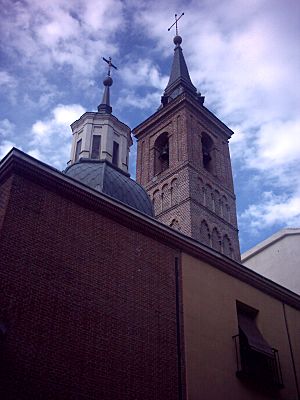St Nicholas' Church, Madrid facts for kids
Quick facts for kids Church of San Nicolás |
|
|---|---|
| Native name Spanish: Iglesia de San Nicolás |
|
 |
|
| Location | Madrid, Spain |
| Official name: Iglesia de San Nicolás | |
| Type | Non-movable |
| Criteria | Monument |
| Designated | 1978 |
| Reference no. | RI-51-0004262 |
| Lua error in Module:Location_map at line 420: attempt to index field 'wikibase' (a nil value). | |
The Church of San Nicolás (in Spanish: Iglesia de San Nicolás), sometimes called the Church of San Nicolas de Bari, is a Catholic parish church in central Madrid, Spain.
This church is very old, dating back to medieval times. However, it has been changed and updated many times over the centuries. In 1978, the building was named a Bien de Interés Cultural, which means it's a special cultural heritage site in Spain. Its tall tower was already protected, having been declared a national monument way back in 1931. It is one of the oldest churches you can find in Madrid today.
History of the Church
The Church of St. Nicholas in Bari is mentioned in old records from Madrid in 1202. This shows it was one of the city's first churches. Today, it is the oldest church still standing in Madrid. This is because the Church of Santa Maria de la Almudena was taken down.
Some old findings suggest that the church and its bell tower might have been part of an older mosque. It was probably built around the 12th century. The main part of the church and its smaller prayer areas were updated in the 17th century.
By the 1800s, this church didn't have many people attending or much money. In 1805, it joined with another church called El Salvador. For a while, the building was empty. Then, in 1825, it was given to a religious group called the Third Order of Servites. When the nearby El Salvador church was destroyed in 1842, the Church of San Nicolás became a main parish church again.
In 1891, the main church services moved to a different building. This new location is now called the Parish of San Nicolas and San Salvador. The old building then became known as the "Church of St. Nicholas of the Servites." This name comes from the Servite Order, who still own it today.
Towards the end of the 20th century, the church had some important repair work done. A major renovation happened in 1983. During some of these repairs, parts of the stone were replaced. This was especially true in the back part of the church, called the apse.
What the Church Looks Like
The Church of San Nicolás has been repaired and changed many times over hundreds of years. This is why it looks the way it does now. It has three main sections inside, called naves. The back part, or apse, was built in the 15th century using cut stone. The window in the apse, which lets light in, is framed with granite. The church also has a beautiful Mudejar style ceiling over the main nave and a Gothic style ceiling in the apse.
The most interesting part of this church is definitely its tower. The tower itself dates back to the 12th century. However, the pointed top, called a Herrerian style spire, was added in the 18th century and is made of slate. The tower is square-shaped and built from brick. It has decorations made of blind arches, which are arches that are filled in. The bricks at the bottom are larger, while the bricks in the bell tower area are smaller and a different color. This tower might have been one of the old Arab minarets (towers used for calls to prayer) that were in the city. The tower was changed in the 14th century, and its top was later replaced by the current spire.
The church has two entrances. Both have doorframes and tops (jambs and lintels) made of granite. The main entrance is a beautiful Baroque style doorway. It was carved in the 18th century by Luis Salvador Carmona. You can see an image of St. Nicholas carved into it. The entire front part of the church around this entrance is made of brick. These bricks are laid out differently and are different sizes from the rest of the building.
The other entrance is a rounded door. It is set into a wall made of flint stones at the bottom. Above this, the wall changes to brick with stone sections, a style sometimes called "rigging Toledo". This front wall also has some dolomite-limestone stones. At the top, this part of the church has three windows and a balcony, all made of brick.
See also
 In Spanish: Iglesia de San Nicolás (Madrid) para niños
In Spanish: Iglesia de San Nicolás (Madrid) para niños
- Catholic Church in Spain
- List of oldest church buildings
- Romanesque churches in Madrid


